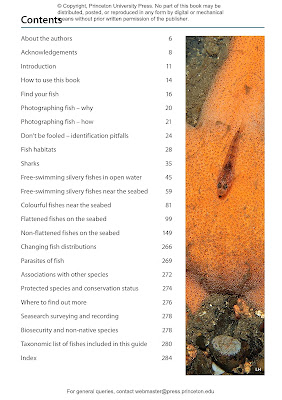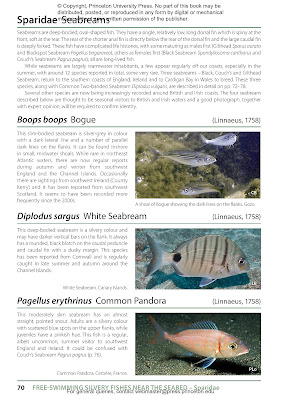“An unexpected topic for Another Bird Blog”, regular readers might say, a review of Inshore Fishes of Britain and Ireland, a field guide to fish. A soon to be released book from Wild Nature Press via Princeton (25 April).
Inshore Fishes of Britain and Ireland - Princeton
Let me explain. I live a two minute drive from the Lancashire coast, the wonderfully species rich ecosystem of North West England known as Morecambe Bay, where man, birds, animals and fish live together, often in competition, very frequently as prey and predator.
The historic and once major fishing town of Fleetwood is a short ferry journey across the mouth of Morecambe Bay via The River Wyre, a focal point of the geographical area. Hereabouts, many people retain an affinity to what is today a mostly lost industry. The important source of employment declined during the 'cod wars' of the 1970s when Iceland restricted how much fish could be caught in its waters. Later in the 1990s many fishermen sold their boats off under a UK government and EU led decommissioning scheme. And thereafter Fleetwood lost its main raison d'être.
I will own up now; I like to eat fish. Fish is a rich source of protein filled with omega-3 fatty acids and vitamins such as D and B. Fish is rich in calcium and phosphorus and a great source of minerals, such as iron, zinc, iodine, magnesium, and potassium.
My pal Jamie the Fishmonger has skills acquired via his Fleetwood family where he learnt the trade of knowing about the buying, selling and the processing of many sea foods. He can tell me how good a fish will eat by glancing at the colour of the flesh or feeling the thickness of the skin. He knows about fish where I know the bare bones; he educates me about his iced display of treasure from the deep while filleting a bright eyed plaice in the blink of an eye.
When Princeton floated Inshore Fishes of Britain and Ireland my naturally enquiring mind came into play whereby a landlubber’s curiosity might learn a little about the 400 or more species of fish which surround UK shores. After a quick shuffle of the pages, the many photos and the explanatory illustrations I just knew I had to share this gem of a book with followers of Another Bird Blog, so here it is.
Unlike birds and mammals, fish in their live state are not obvious or easily accessible to land based observation but much more likely to be seen and studied by divers and snorkellers who can more easily identify and record these fast moving animals underwater.
The authors of Inshore Fishes, Lin Baldock and Frances Dipper have a wealth of expertise and worldwide experience of studying marine life through diving expeditions in the UK, Canada, Australia, the Middle East and Asia. As one who paddled in the Red Sea while surrounded by myriad exotic fish I remain in awe of Lin Baldock’s 4,000+ dives. At Page 8 the authors acknowledge more than seventy contributors who provided photographs, illustrations, previously unpublished information and other content that made this overdue and unique book possible.
A glance at “Contents” shows the diversity, breadth of the species and the information to be found in this delightful and educational book of a succinct 288 pages.
Inshore Fishes of Britain and Ireland - Princeton
“How to Use This Book” is essential reading to understand that unusually shaped fish can change both colour, shape and even sex, but that Habitat is equally important for fish identification as it is for bird and animal ID.
The why and how of underwater photography points out the potential pitfalls and likely delights of portraying a pipefish or flashing to a flounder while showing many fine examples by way of e.g. Leopard-spotted Goby, a Starry Smoothound, a Norwegian Topknot or an Angelshark in their natural environments.
Inshore Fishes of Britain and Ireland - Princeton
Inshore Fishes of Britain and Ireland - Princeton
And if you thought that some birds are pretty good at hiding away through cryptic plumage take a look at the photographs of a number of species of flat fish like brill, turbot and scaldfish. Such beautiful and unique creatures have the means to become motionless and invisible to all but the sharpest eyes.
Inshore Fishes of Britain and Ireland - Princeton
Inshore Fishes of Britain and Ireland - Princeton
Some pages emphasise key identification features and possible confusion species and also include a “confidence guide” distinguishing between easily recognisable species and those requiring closer examination. It’s a feature that could be put to good use in bird guides for novice birders when considering recent faux pas I witnessed - Short-eared Owl v Barn Owl or Wood Warbler v Willow Warbler, occasions when the use of a field guide would have saved embarrassment.
The species’ accounts at pages 35-273 make for truly fascinating and compulsive reading in their descriptions and explanations of the remarkable lifestyles and life histories of these barely known creatures, many of which were completely unknown to me.
There are of course a number of UK species which can sting, electrocute or otherwise harm an unwary diver - the rays, sharks, scorpion fish, or the venomous weevers. Yet others like the wrasse family live close to the sea bed where they can be rare or rarely seen. I learnt that the Black Seabream, a protogynous hermaphrodite, bulldozes a nest on the ocean floor for the female and that this extraordinary behaviour has been the subject of a seven year study along the Dorset coast.
With Inshore Fishes and following on from a number of very bulky “field guides” we appear to have returned to a more manageable size of guide at a pocket sized 5.88 x 8.25 inches of minimal weight and mass. The colour coded on-page icons, pointers and illustrations work a treat. The book is concise, compact, practical and extremely user friendly. Hooray.
Inshore Fishes is published in association with the UK Marine Conservation Society, a joint imitative that makes an invaluable contribution to the series of marine photographic titles of Seasearch, a species recording project for volunteer sports divers.
Inshore Fishes of Britain and Ireland - Princeton
Price: $27.95/£22.00
ISBN: 9780691249018
Published (US):Aug 1, 2023
Published (UK):Apr 25, 2023
Copyright:2023
Pages: 288
Size: 5.88 x 8.25 in
Here is a fine book that will appeal to the growing band of divers and marine conservationists who explore the coast of Britain. I imagine that many fishermen will be drawn to read this book, also part time sea anglers or those inshore hobby fishermen who set off in small boats from towns and villages around all parts of Britain and Ireland. In the book they will surely find much to interest, excite and educate.
Linking this weekend to Eileen's Saturday Blog and Anni in Texas.




















.jpg)













10 comments:
Very Insightful There Brother Man - Big Fan Of Underwater Shots - Be Well
Cheers
Good reading and we both love fish and prefer it to meat, sadly the prices are getting higher and higher and we now only eat fish when there are special offers!!
There are some very beautiful fish in this world and the book looks extremely interesting.
Have a good weekend, cheers Diane
Sounds like an amazing book.
I wasn't expecting this for Another Bird Blog though!
Have a wonderful weekend, Phil
It may seem unusual for a birder like yourself to be interested in fish, but the book appears to be intriguing. Drawing comparisons between the adaptation and defense mechanisms of fish and birds could be an immensely fascinating study.
Hello Phil
It sounds like a great book Phil, the underwater photos are amazing.
I love most seafood, I hope the fishing and the whole seafood industry will continue to do well. Thank you for linking up and sharing your post. Take care, have a great weekend.
Another great book review by Another Bird Blog!
Gini and I both grew up in fishing families. Florida is surrounded on three sides by salt water and is pock-marked throughout the interior with fresh water lakes. We fondly recall trying to identify the finny creatures which we pulled from the waters by hook and line or net.
You are not alone in your fondness for enjoying fish for dinner! Or, in our case, for breakfast or snack as well.
Thank you for sharing a great resource.
I love reading books like this and seeing the photos. I like to eat fish too and the very first conversation I had with my husband 'to be' was about fly fishing. I lived on a stream and loved to fish. He was interested! lol Enjoy your weekend!
Hello Phil
Wonderful narration, about what seems to be a fascinating book. I know very little about marine life, which is not surprising because I have never fished, and can't swim underwater.
I do love to eat fish however, and it is on the menu several times every week. Turbot, Halibut and Salmon are some of my favourites.
All the best.
Well, most waders need fish so I guess that is the 'tie-in' to birds this week?
Thanks for sharing this blog with us at IRBB!
We do enjoy eating fish ...
This sounds a very good book.
All the best Jan
Post a Comment